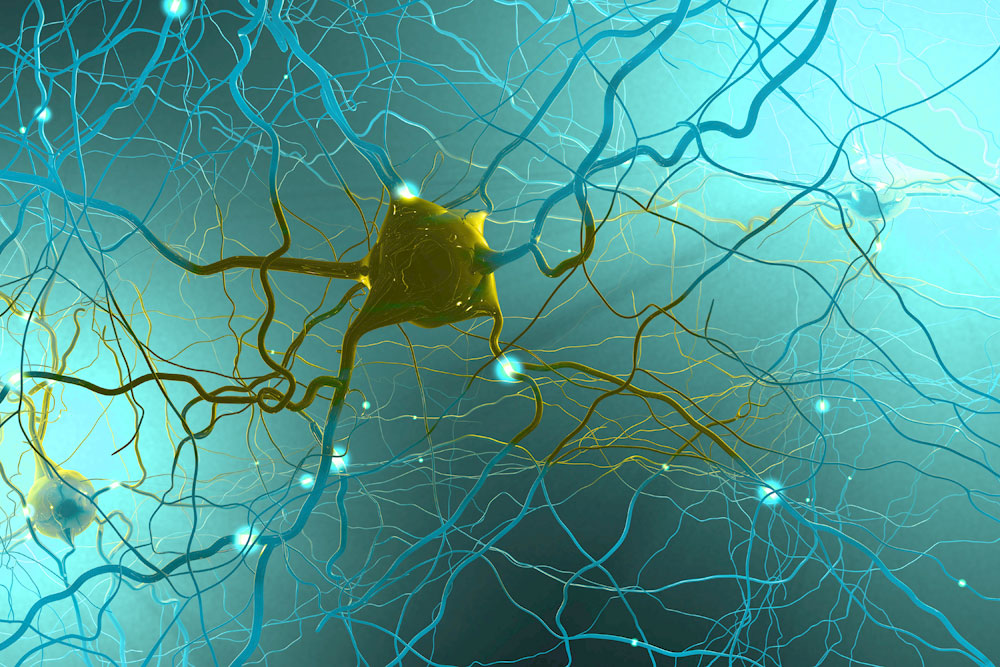
Countless interactions between nerves and other cells in the body create the sensory responses, including pain, that allow us to interact with the world. Researchers from The University of Texas at Dallas’ Center for Advanced Pain Studies (CAPS) are cataloging those interactions, hunting for the molecular reactions that produce dysfunctional chronic pain with the hope of better treating it in the future.
In a recent study published March 16 in Science Signaling, a team of CAPS scientists used a massive repository of RNA sequencing data to produce a map of how specific types of cells interact with peripheral sensory neurons. In the process, they located a new pain-inducing molecule that could be a target for future pain-relief treatments.
Dr. Ted Price BS’97, Eugene McDermott Professor of neuroscience in the School of Behavioral and Brain Sciences (BBS) and CAPS director, is the corresponding author of the paper, which he describes as pointing to “something new and interesting.”
“Heparin-binding epidermal growth factor, or HBEGF, is a ligand for a receptor that no one had studied in a pain context before, and sure enough, we found that it induces pain,” Price said. “With human RNA sequencing data that we generated previously — along with existing data from mice — we’re trying to better understand what’s driving chronic pain.”
RNA is a cousin of DNA, and it carries information to help cells regulate genes and make proteins. That information is encoded in sequences of nucleotides that make up RNA molecules — sequences that can be read like letters in a word.

“Using the interactome, we can highlight specific interactions within this overwhelming data that are present in multiple disease models in humans. While there are certainly papers out there generating data for the scientific community, they often perform little or no analysis. We’ve provided the mechanism for that dataset analysis.”
Andi Wangzhou MS’15
For this project, cognition and neuroscience doctoral student Andi Wangzhou MS’15 used the RNA catalog to create an algorithm for an “interactome” — a maplike framework cataloging potential interactions between target tissues and sensory neurons.
Using that map, Price’s team examined tissue samples that exhibited dysfunctional pain. Their goal was to understand how the soluble signaling factors — molecules that cells use to communicate with one another — in those tissues interact with the neurons that originate pain signals. They did this for tissue samples from painful diseases such as osteoarthritis, rheumatoid arthritis and pancreatic cancer.
“An RNA sequencing dataset is enormous. You need some way to sort through it. Andi’s interactome algorithm allows us to focus in on the things that are important,” Price said. “It’s one of the neater examples of using innovative bioinformatics to discover something new about how the pain system works.”
Wangzhou said that, because of the raw number of upregulated or downregulated genes across the genome, molecules as useful as HBEGF can remain undiscovered.
“Using the interactome, we can highlight specific interactions within this overwhelming data that are present in multiple disease models in humans,” he said. “While there are certainly papers out there generating data for the scientific community, they often perform little or no analysis. We’ve provided the mechanism for that dataset analysis.”
While HBEGF does hold some potential, Price emphasized the greater significance of the interactome platform for future research.
“The HBEGF finding is certainly interesting, but it is not necessarily going to transform how we think about treating pain,” he said. “The interactome platform can be applied in almost any situation that involves communication between cells to understand how changes in cell-to-cell communication may drive disease.”
Price said that the platform can increase the value of other sequencing projects.
“You can go back in the literature and use prior datasets in new ways to gain new insights into neuroscience or into pharmacology by building the bioinformatic infrastructure out as we have,” he said.
One of the key findings in the study is an emphasis on the complexity of the potential interactions found in these “maps.” Price tied that to the difficulty in finding a one-drug-fits-all pain solution.
“Most pain therapeutics focus on a single factor, but not all patients respond to any of these therapeutics,” he said. “Our work shows that chronic-pain disease states are accompanied by complex changes that indicate multiple interactions need to be simultaneously targeted. Our work starts to provide a toolkit to quantify these interactions and design therapeutic strategies that have a better chance of success.”

Price believes that the work’s basis in results from human data distinguishes it from other research within the field.
“We have done an enormous amount of sequencing on human nervous system tissues, including dorsal root ganglia from spinal-surgery patients,” he said. “Those are some of our foundational datasets. I think that provides us a great opportunity to identify targets and biomarkers.”
Candler Paige, a cognition and neuroscience doctoral student and author on the paper — who like Wangzhou will graduate in May — has joined her two colleagues in forming a startup, called Doloromics, based on the platform created for the paper. They have joined the Illumina Accelerator program, a venture arm of Illumina, which is the largest gene-sequencing company in the world.
“Doloromics is using next-generation sequencing and the interactome to identify new drug targets and biomarkers for chronic pain,” said Paige, who is CEO and co-founder of the company. “We’ll achieve this using our proprietary algorithms to analyze existing human datasets to identify novel drug targets and biomarkers in chronic pain patients to help identify individualized treatment options.”
Paige and Price said that chronic pain is a starting point for the company, with an eye to expanding next to motor neuron dysfunction diseases such as multiple sclerosis or amyotrophic lateral sclerosis, known widely as Lou Gehrig’s disease.
“We are really hopeful that this idea can be the start of a real effort toward personalized, molecular mechanism-based treatment for pain,” Price said.
Other authors of the paper include Dr. Gregory Dussor, associate professor of neuroscience and Fellow, Eugene McDermott Professor; BBS research scientist Dr. Pradipta Ray; cognition and neuroscience doctoral students Eric David, Moeno Kume and Dhananjay Naik; and neuroscience senior Sanjay Neerukonda.
Funding was provided by three grants (NS113457, NS065926 and NS102161) from the National Institutes of Health’s National Institute of Neurological Disorders and Stroke.